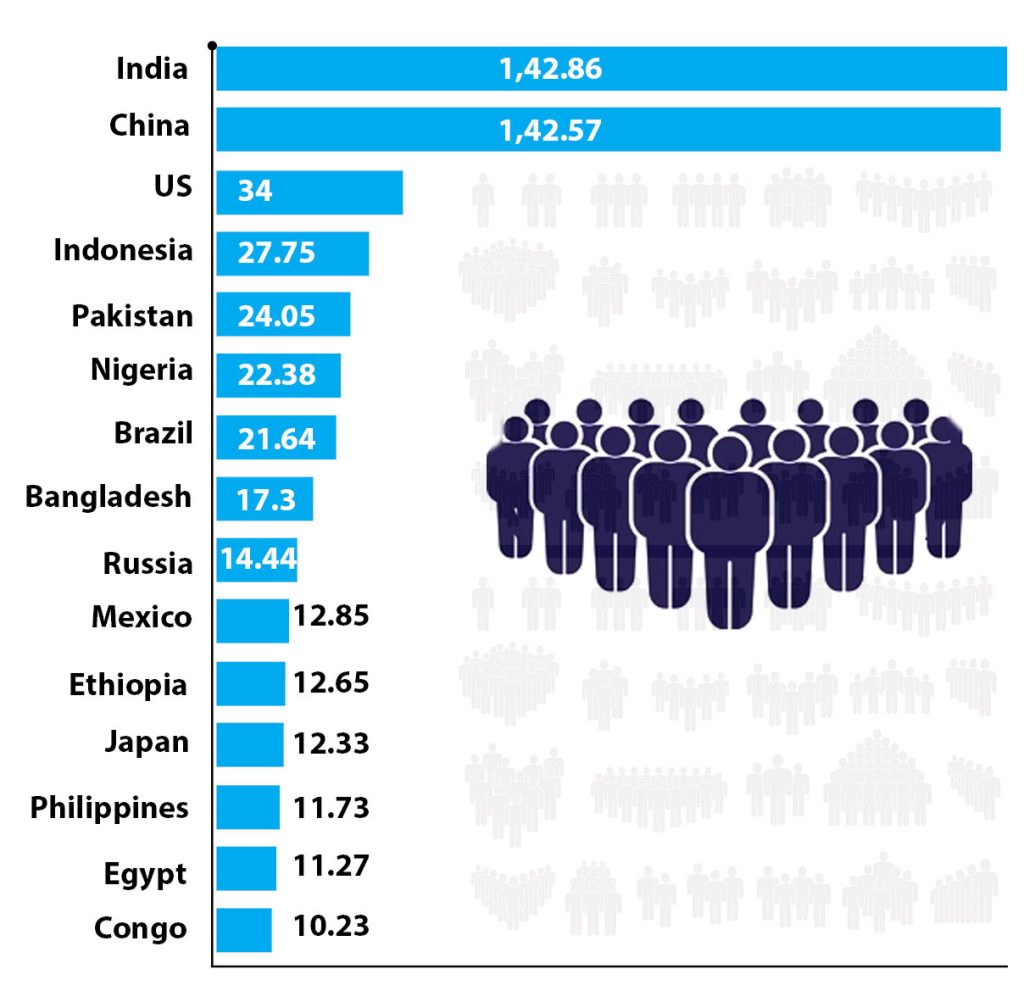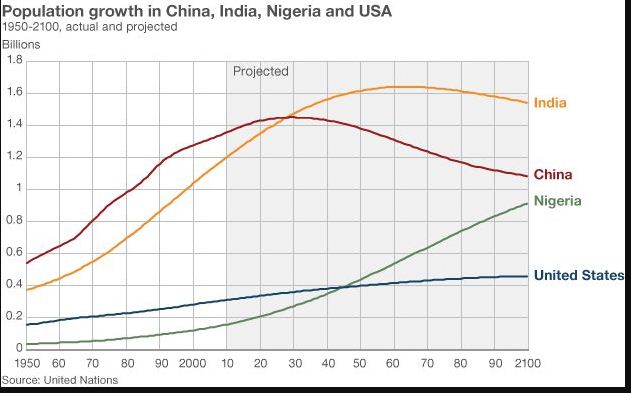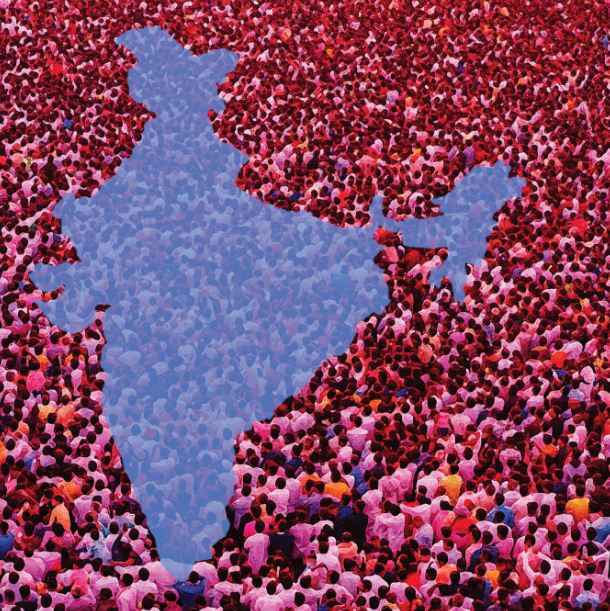By Chanakya
The UN world population dashboard has stated that India now has 1428.6 million people while China’s population stands at 1425.7 million. This means that India is now officially the most populous country int eh world, leading China by 3 million. The UN began collecting population data in 1950.
China had an interesting take on this development. Chinese Foreign Ministry spokesman Wang Wenbin told the media: “I want to tell you that population dividend does not depend on quantity but also quality”.
It is now being debated whether this is good or bad for India. We will deal with the several individual issues that are affected.
India, with its enormous population, has long been hailed as having the potential for a demographic dividend a phenomenon where a young and productive workforce can fuel economic growth and development. However, as India now surpasses China to become the most populous country in the world, it is increasingly evident that this so-called demographic dividend may turn into a demographic disaster if adequate measures are not taken.
Despite the potential benefits of a large young population, India faces significant challenges that threaten to undermine its ability to utilize this demographic advantage to its benefit. Will it be possible for India to avoid the negative consequences of its growing population?
Need for more scientific family planning measures
India once had a history of implementing coercive population control measures, such as forced sterilizations, leading to human rights abuses that created a sense of fear and mistrust among the population. That was lead by Sanjay Gandhi quite some time back. Thereafter, though, India moved to family welfare, and things had been streamlined a bit.
Therefore, instead of relying on coercive measures, it is essential for the government to focus on introducing more scientific and voluntary family planning measures – some of which have already been in place – that empower individuals and couples to make informed choices about their reproductive health. This includes increasing access to modern contraceptives, comprehensive sexuality education, and addressing social and cultural norms that perpetuate large family sizes.


Additionally, it is important to prioritize the involvement of women and girls in decision-making processes related to reproductive health and family planning, as empowering women has been shown to have a positive correlation with smaller family sizes.
Need for better health projects for the poor
Health is a critical component of human well-being and development. In India, the poor often face inadequate access to quality healthcare, leading to increased morbidity and mortality rates. This not only affects the physical well-being of individuals but also has economic implications, as poor health can result in lost productivity and increased healthcare costs. The government must invest in improving the healthcare infrastructure, especially in rural areas, and ensure that affordable and quality healthcare services are accessible to all, regardless of their socio-economic status. This includes increasing the availability of primary healthcare facilities, strengthening health systems, and investing in preventive healthcare measures such as vaccinations and health awareness campaigns.
It had been said by the current dispensation that it would greatly increase the budgetary allocation on health but, despite the devastation caused by Covid, this did not happen. Primary health centres exist only as skeletons, without facilities or doctors. This has resulted in children with malnutrition and related diseases, which means that much of that so-called demographic dividend is actually in sick bay.
Primary education for the poor
The distant dream of proper and cheap primary education for the poor remains as such, a dream. Education is a fundamental right and a key driver of social and economic development. However, in India, access to quality education remains a distant dream for many of the poor. Poor infrastructure, lack of qualified teachers, and inadequate resources often result in substandard education in rural areas, leading to high dropout rates and low literacy levels.
To fully utilize its demographic dividend, India must prioritize education as a top national agenda. This includes increasing investment in education, improving the quality of schools and educational resources, and ensuring that education is accessible to all, including marginalized communities.


Additionally, there is a need to focus on vocational and skill-based education to equip the youth with relevant skills that are in demand in the job market.
Freshwater shortages and impact on the poor
Water scarcity is a growing concern in India, with many regions facing acute shortages of freshwater due to over-extraction, pollution, and climate change. This has severe consequences for the poor, who are often the most vulnerable to the impacts of water scarcity. Lack of access to clean water affects hygiene, sanitation, and health, leading to increased water-borne diseases and reduced productivity.
India must prioritize sustainable water management practices, including water conservation, groundwater recharge, and watershed management, to ensure adequate availability of freshwater for all its citizens, particularly the poor. Additionally, there is a need to improve water infrastructure and sanitation facilities in rural areas to ensure access to safe drinking water and sanitation services.
Potential burden of mass migration to cities on infrastructure and agriculture
Rapid urbanization is a growing trend in India, with many people moving from rural areas to cities in search of better livelihoods will increase when rural India can no longer support the hunger pangs of a huge population. That will result in more cities bursting at the seams.
It will be essential for the government to create opportunities of sustainability with rural India to accommodate the growing population.
The micro and small sector
This brings the focus back to the country and its enormous population, has had long been hailed as having the potential for a demographic dividend, where a young and productive workforce can fuel economic growth and development. However, as we have seen earlier, the benefits of this demographic advantage may not be evenly distributed across the population. With the micro and small industry sectors having been almost wiped out due to government apathy (as well as Covid and the economic slowdown that preceded it) the unskilled and semi-skilled labourers of India face a bleak future.
The micro and small industry sectors are the largest employers in India, accounting for nearly 40% of the total workforce. However, these sectors have been severely impacted by a lack of support from the government.


These industries face numerous challenges, such as limited access to finance, inadequate infrastructure, and inadequate technology, making it difficult for them to compete in the global market. The government’s apathy towards these sectors has resulted in the closure of many businesses, leaving thousands of people unemployed.
The impact of the government’s neglect of these sectors will be felt most acutely by the unskilled and semi-skilled labourers of India. These workers often lack formal education and training, and are therefore more likely to be employed in the micro and small industry sectors. The closure of these businesses will leave many of these workers without any means of livelihood, exacerbating the already existing problem of unemployment in the country.
Additionally, the lack of support for these sectors has also led to a decline in the quality of employment opportunities. Many of the jobs in the micro and small industry sectors are low-paying and offer few benefits. With the closure of these businesses, workers are likely to be forced to accept even lower-paying jobs, further reducing their standard of living.
Furthermore, the impact of the closure of these industries will also be felt by the wider economy. The micro and small industry sectors are a vital part of the supply chain for many larger industries, and their closure will have a ripple effect on the entire economy. This could lead to a reduction in economic growth, further exacerbating the problem of unemployment.
To address this issue, the government must take immediate steps to support the micro and small industry sectors. This includes providing easier access to finance, improving infrastructure, and providing technology and training support. The government must also take steps to encourage the growth of these sectors, such as reducing regulatory burdens and providing incentives for businesses to invest in these sectors.
Need for re-skilling
In addition to supporting the micro and small industry sectors, the government must also invest in the education and training of the unskilled and semi-skilled labourers. This will equip them with the skills needed to take advantage of new job opportunities that may arise in emerging industries. Furthermore, the government must also create more formal jobs in the public and private sectors to absorb the large number of unemployed workers.
Worrying inequalities
India has emerged as one of the fastest-growing economies in the world, but experts are concerned about the prevalent huge inequalities in society. As the low-to-mid income generating population largely feels the heat, consumption is seeing a sharp slowdown, and household savings have slumped to a three-decade low, as per media reports. There are also concerns around poor female participation rate in the workforce and a lagging rural economy, in comparison to China.
Even as both countries – India and China – see workers migrate to the cities for better prospects, the majority of India’s people will remain in the hinterland, while the bulk of China will increasingly be urban by 2035, according to estimates from UN-Habitat.


The year before, China’s population shrank for the first time since 1960. In 2016, Beijing ended its strict “one-child policy,” imposed in the 1980s amid overpopulation fears, and began letting couples have three children in 2021.
China faces an impending demographic decline, as its workforce ages and fertility rates decrease. Meanwhile, the United States is in the third position with an estimated population of 340 million.
The annual United Nations Population Fund (UNFPA) State of the World Population Report (SWOP) 2023 indicated that respondents in India held the opinion that the population in their country was “too large” and fertility rates “too high”.





















